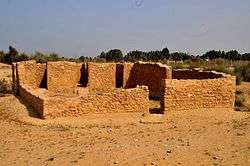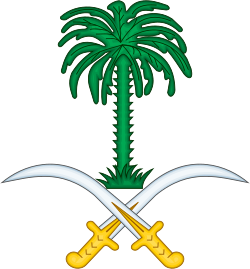Jubail Church
Jubail Church (Classical Syriac: ܥܕܬܐ ܕܡܕܢܚܐ ܕܐܬܘܖ̈ܝܐ, romanized: ʿĒḏtā ḏ-Maḏnḥā ḏ-ʾĀṯūrāyē, Arabic: كنيسة الجبيل) is a 4th-century church building near Jubail, a city in the Eastern province on the Persian Gulf coast of Saudi Arabia.
| Jubail Church | |
|---|---|
كنيسة الجبيل | |
 Jubail Church | |

| |
| Location | Jubail |
| Country | |
| Denomination | Christianity |
| Architecture | |
| Completed | 4th-century |
History
Discovered in 1986, it originally belonged to the Church of the East, a branch of Eastern Christianity in the Middle East. The majority of its adherents are ethnic Assyrians.
Recently, they have put a fence around the church to prevent potential tourists from seeing it. However, the fences have not stopped locals from coming in to vandalise and damage the building. Churches are officially banned in Saudi Arabia and a limited number of Christians, mostly westerners, are permitted to worship in private as long as no Christian symbols are openly visible.[1][2][3][4][5][6]
The Saudi government hides it from locals and even archaeologists as the Kingdom follows a strict version of Islamic law and prohibits all non-Islamic forms of worship.
See also
- List of the oldest churches in the world
- Christianity in Saudi Arabia
Notes
- Ham, Anthony (2004). Lonely Planet: Saudi Arabia. p. 158. ISBN 978-1-74059-667-1. Retrieved 1 September 2009.
- J.A. Langfeldt, "Recently Discovered Early Christian Monuments in Northeastern Arabia", Arabian Archaeology and Epigraphy, 5 (1994), 32–60 .
- Changing Identities in the Arabian Gulf: Archaeology, Religion, and Ethnicity in Context T. Insoll – The Archaeology of Plural and Changing Identities, 2005 – Springer "He mentions how access to the monuments was restricted, and how the church in Jubail supposedly had its impressed crosses obliterated. Besides vandalism, the presence of these Christian remains caused a debate over what exactly they signified."
- The Nestorians in the Gulf: Just Passing Through? Recent Discoveries on the Island of Sir Bani Yas, Abu Dhabi Emirate, UAE J Elders – Archaeology of the United Arab Emirates, 2003 "There are sites along the Gulf coast of Saudi Arabia, at Jubail (Langfeldt 1994), and inland at Thaj and also Jebel Berri (Potts 1994). There is at least one. possibly two. church sites on Qatar."
- A Pre-Islamic Christian site on Sir Bani Yas G R D King, P Heliyer – Tribulus, 1994 ".. Bani Yas discovery can also be related to the discovery of a church with a fine cross at Failaka, in Kuwait, in 1990 by Vincent Bernard and JF Salles. Their stucco crosses are dated to the Fifth-Sixth Centuries AD. The discovery of two churches and crosses at Al Jubail and Thaj ..."
- Crossing the Line L Castoro – 2002 – The lost churches of the Arabian Gulf: recent discoveries on the islands of Sir Bani Yas and Marawah, Abu Dhabi emirate, United Arab Emirates J Elders – Proceedings of the Seminar for Arabian Studies, 2001 "There are two known sites along the Gulf coast of Saudi Arabia, at Jubail (Langfeldt 1994) and slightly inland at Jebel Berri (Potts 1994). There are unconfirmed but persistent reports of at least one, more probably two church sites on Qatar."
External links
- Ancient Churches in Saudi Arabia (Crossroads Arabia blog site)
- fourth Century Assyrian Church in Saudi Arabia Assyrian International News Agency 2010 (with pictures)
